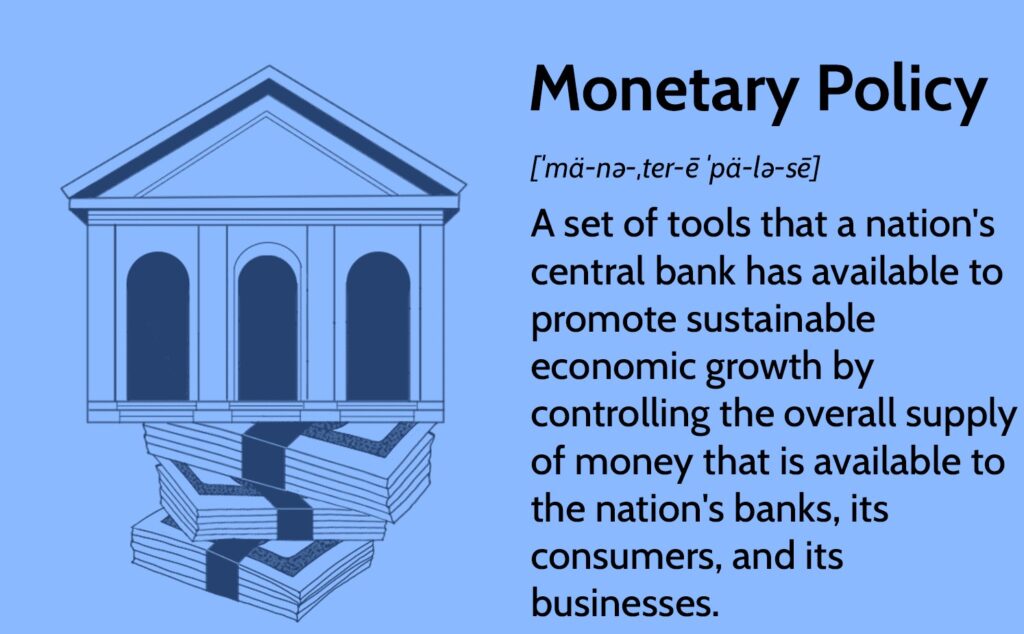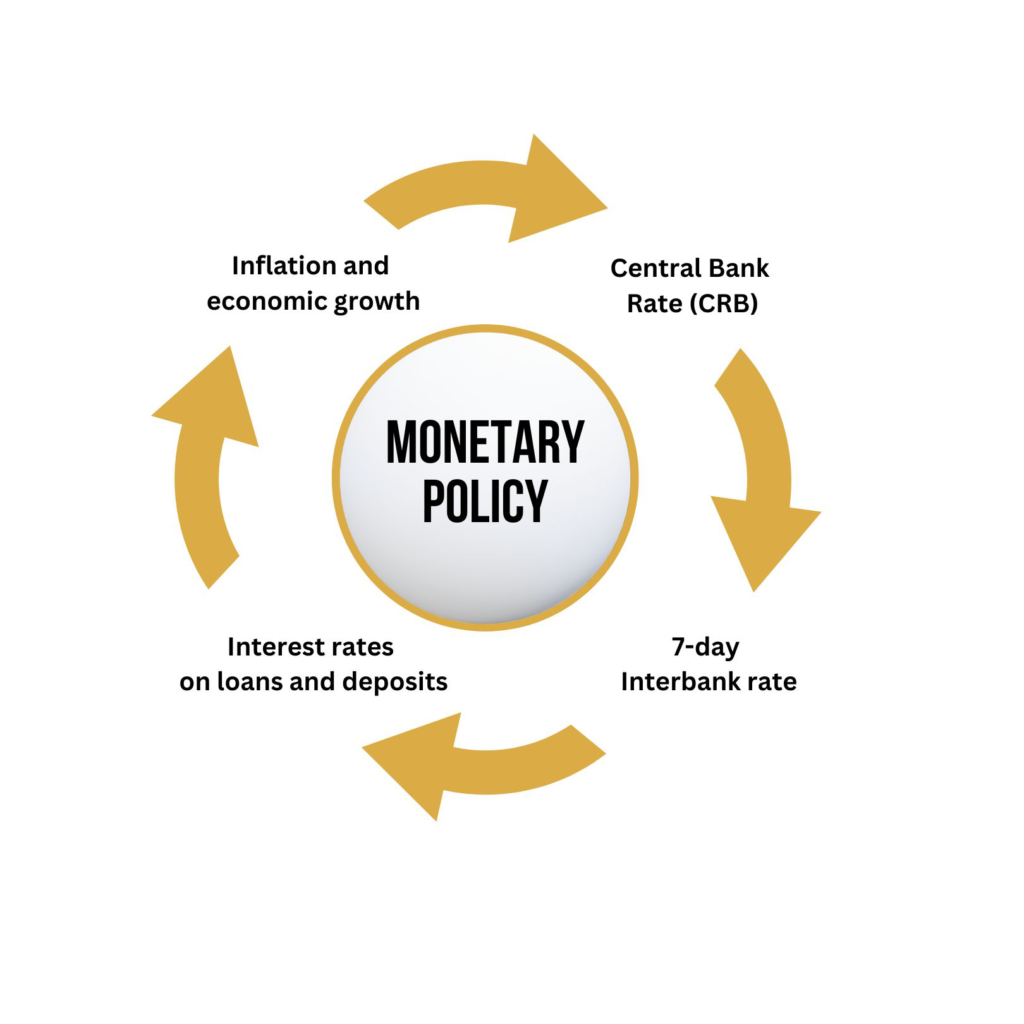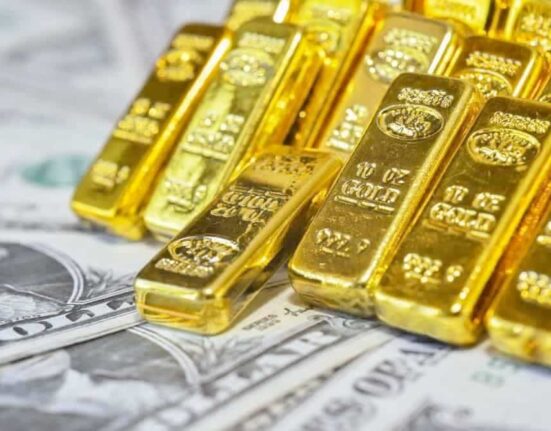What Is Monetary Policy?
Monetary policy is a set of tools used by a nation’s central bank to control the overall money supply and promote economic growth and employ strategies such as revising interest rates and changing bank reserve requirements.
In the United States, the Federal Reserve Bank implements monetary policy through a dual mandate to achieve maximum employment while keeping inflation in check.1
KEY TAKEAWAYS
- Monetary policy is a set of actions to control a nation’s overall money supply and achieve economic growth.
- Monetary policy strategies include revising interest rates and changing bank reserve requirements.
- Monetary policy is commonly classified as either expansionary or contractionary.
- The Federal Reserve commonly uses three strategies for monetary policy including reserve requirements, the discount rate, and open market operations.

Understanding Monetary Policy
It is the control of the quantity of money available in an economy and the channels by which new money is supplied.
Economic statistics such as gross domestic product (GDP), the rate of inflation, and industry and sector-specific growth rates influence monetary policy strategy.
A central bank may revise the interest rates it charges to loan money to the nation’s banks. As rates rise or fall, financial institutions adjust rates for their customers such as businesses or home buyers.
Additionally, it may buy or sell government bonds, target foreign exchange rates, and revise the amount of cash that the banks are required to maintain as reserves.
Types of Monetary Policy
Monetary policies are seen as either expansionary or contractionary depending on the level of growth or stagnation within the economy.
Contractionary
A contractionary policy increases interest rates and limits the outstanding money supply to slow growth and decrease inflation, where the prices of goods and services in an economy rise and reduce the purchasing power of money.2
Expansionary
During times of slowdown or a recession, an expansionary policy grows economic activity. By lowering interest rates, saving becomes less attractive, and consumer spending and borrowing increase.1
Goals of Monetary Policy

Inflation
Contractionary monetary policy is used to temper inflation and reduce the level of money circulating in the economy. Expansionary monetary policy fosters inflationary pressure and increases the amount of money in circulation.
Unemployment
An expansionary monetary policy decreases unemployment as a higher money supply and attractive interest rates stimulate business activities and expansion of the job market.
Exchange Rates
The exchange rates between domestic and foreign currencies can be affected by monetary policy. With an increase in the money supply, the domestic currency becomes cheaper than its foreign exchange.
Tools of Monetary Policy

Open Market Operations
In open market operations (OMO), the Federal Reserve Bank buys bonds from investors or sells additional bonds to investors to change the number of outstanding government securities and money available to the economy as a whole.3
The objective of OMOs is to adjust the level of reserve balances to manipulate the short-term interest rates and that affect other interest rates.3
Interest Rates
The central bank may change the interest rates or the required collateral that it demands. In the U.S., this rate is known as the discount rate.4 Banks will loan more or less freely depending on this interest rate.
The Federal Reserve commonly uses three strategies for monetary policy including reserve requirements, the discount rate, and open market operations.
Reserve Requirements
Authorities can manipulate the reserve requirements, the funds that banks must retain as a proportion of the deposits made by their customers to ensure that they can meet their liabilities.
Lowering this reserve requirement releases more capital for the banks to offer loans or buy other assets. Increasing the requirement curtails bank lending and slows growth.
Monetary Policy vs. Fiscal Policy
Monetary policy is enacted by a central bank to sustain a level economy and keep unemployment low, protect the value of the currency, and maintain economic growth. By manipulating interest rates or reserve requirements, or through open market operations, a central bank affects borrowing, spending, and savings rates.
Fiscal policy is an additional tool used by governments and not central banks. While the Federal Reserve can influence the supply of money in the economy and impact market sentiment, The U.S. Treasury Department can create new money and implement new tax policies.5 It sends money, directly or indirectly, into the economy to increase spending and spur growth.6
Both monetary and fiscal tools were coordinated efforts in a series of government and Federal Reserve programs launched in response to the COVID-19 pandemic.7
How Often Does Monetary Policy Change?
The Federal Open Market Committee of the Federal Reserve meets eight times a year to determine changes to the nation’s monetary policies.8 The Federal Reserve may also act in an emergency as was evident during the 2007-2008 economic crisis and the COVID-19 pandemic.
How Has Monetary Policy Been Used to Curb Inflation In the United States?
A contractionary policy can slow economic growth and even increase unemployment but is often seen as necessary to level the economy and keep prices in check. During double-digit inflation in the 1980s, the Federal Reserve raised its benchmark interest rate to 20%.9 Though the effect of high rates spurred a recession, inflation was reduced to a range of 3% to 4% over the following years.10
Why Is the Federal Reserve Called a Lender of Last Resort?
The Fed also serves the role of lender of last resort, providing banks with liquidity and regulatory scrutiny to prevent them from failing and creating financial panic in the economy.11
The Bottom Line
Monetary policy employs tools used by central bankers to keep a nation’s economy stable while limiting inflation and unemployment. Expansionary monetary policy stimulates a receding economy and contractionary monetary policy slows down an inflationary economy. A nation’s monetary policy is often coordinated with its fiscal policy. Know more about it visit here.
Disclaimer ||
The Information provided on this website article does not constitute investment advice ,financial advice,trading advice,or any other sort of advice and you should not treat any of the website’s content as such.
Always do your own research! DYOR NFA
Coin Data Cap does not recommend that any cryptocurrency should be bought, sold or held by you, Do Conduct your own due diligence and consult your financial adviser before making any investment decisions!



